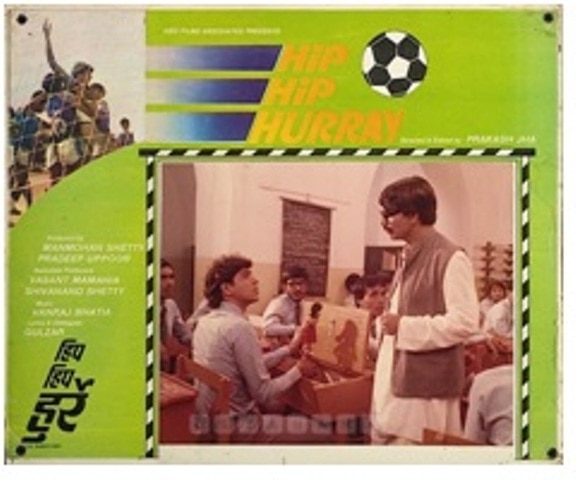Explorer
Hip Hip Hurray

The renewed interest in the coming of age films, a genre that has been around for a while, could be attributed to a combination of two factors – an increase in the number of young actors and the reducing age of the audience. Thanks to a blend of these two, the genre seems to be enjoying its best phase with the last decade and a half witnessing successful films like Dil Chahta Hai, Jab We Met, Wake Up Sid, Love Aaj Kal, Rock On, Zindagi Na Milegi Dobara, Yeh Jawaani Hai Deewani and Tamasha.
Nearly all of these seem to pivot around the same grand ideas – protagonists belonging to a generation that doesn’t really have anything to strive for or their entire existence hinged on the well-being of a relationship – but a few like Wake Up Sid or Udaan were more layered and went beyond the standard exposition. Both Wake Up Sid and Udaan follow the tradition of Prakash Jha’s Hip Hip Hurray (1984), which would perhaps be one of the first true coming of age films in the context of Hindi cinema.
Made within a modest budget of Rs. 12 lakhs, the film marked the debut of Jha as a director and unlike today where it has a hidden but dedicated cult following, the film almost never got made. Jha had been trying to raise funds for Damul but being a script on the trials of the bonded labourers barely had any commercial feasibility in Bombay back then. At the same time, Jha narrated the outline of Hip, Hip Hurray to Manmohan Shetty, the owner of Adlabs and also an up and coming producer.
 Shetty found the prospect of a film based on sports and sportsmanship interesting and with a proposed cast that included Anil Kapoor and Shabana Azmi, Jha was all set to go. But just 25 days before the principal photography was to commence Kapoor backed out and Azmi followed suit. Jha ran from pillar to post and ended up with a cast that made Hip, Hip Hurray look more convincing.
The film uses sports and the sports field as a metaphor for life and juxtaposes the entire course of lives with a game being played where nothing is certain. While waiting for his job to start Sandeep (Raj Kiran), an engineer takes up a temporary job as a sports instructor in a school in Ranchi. Sandeep’s heart might not be in the coaching gig but his sincerity overpowers him once he comes in contact with the rebellious students. He finds his sense of responsibility deepening also because of the opposition he faces from Raghu (Nikhil Bhagat), the student leader of sorts and a principal (Ram Gopal Bajaj), who couldn’t care less. Sandeep also develops a relationship with the history teacher, Anuradha (Deepti Naval). To make matters worse Raghu has a massive crush on Anuradha and considers Sandeep to be a rival.
The thrust of the film might the clash of two states of minds, even two generations that were not too far off, but the focus is clearly on the redemption of Raghu. The lad is burgeoning with misplaced energy; he even flunks every year so that he could continue to be Anuradha’s class and simply pushes away Sandeep’s overtures to start afresh. Although Raghu plays dirty to get Sandeep kicked out of the school, Sandeep continues to be his guardian angel. In his book, 40 Retakes author Avijit Ghosh calls the film special as the narrative makes you a part of the emotional journey without being overtly sentimental. One of the scenes that translates this beautifully is Raghu’s turnaround - standing next to a lamppost in near darkness he is waiting for Sandeep, who walks towards the camera from a distance and when the two come face-to-face not a word is said. Sandeep sees repentance in his student’s eyes and with just a tap on the shoulder, Vanraj Bhatia’s background scores fades in and the next image is a wide shot of the football field where the school’s best player, Raghu, is practising.
The film’s climax is a match between Sandeep’s team and a rival coach (Shafi Inamdar) and Ranjan Kothari’s camerawork makes the proceedings thrilling. Due to the shoestring budget, the entire climax was shot with a single camera unlike the norm of using a multi-camera setup for shooting sports action and this led to every single shot to be filmed three or four times to give the feel of multiple angles. Interestingly even with such a low budget Jha was able to get Gulzar to write the screenplay, dialogues as well as lyrics that included now almost forgotten gems such as Ek subah ek mod par (Yesudas) and Jab kabhi mud ke dekhta hoon main (Bhupinder). The film also made Nikhil Bhagat an overnight star but barring Shyam Benegal’s Trikaal, the stardom was short lived.
Today, coming of age films follow a comparatively linear narrative and the tropes, too, like a road trip, etc. are simpler but Hip, Hip Hurray and Jo Jeeta Wohi Sikandar (1992), yet another film that evocatively captured the young, remain peerless. Prakash Jha is now associated with films far bigger than scores of the much smaller Hip, Hip Huuray but this trailblazer coming of age film perhaps with the exception of Damul continues to be unmatched in the director’s filmography.
Images courtesy: Osianama and Prakash Jha productions
Gautam Chintamani is a film historian and the author of the best-selling Dark Star: The Loneliness of Being Rajesh Khanna (2014) and The Film That Revived Hindi Cinema (2016). He tweets at @gchintamani
Disclaimer: The opinions, beliefs and views expressed by the various authors and forum participants on this website are personal and do not reflect the opinions, beliefs and views of ABP News Network Pvt Ltd.
Shetty found the prospect of a film based on sports and sportsmanship interesting and with a proposed cast that included Anil Kapoor and Shabana Azmi, Jha was all set to go. But just 25 days before the principal photography was to commence Kapoor backed out and Azmi followed suit. Jha ran from pillar to post and ended up with a cast that made Hip, Hip Hurray look more convincing.
The film uses sports and the sports field as a metaphor for life and juxtaposes the entire course of lives with a game being played where nothing is certain. While waiting for his job to start Sandeep (Raj Kiran), an engineer takes up a temporary job as a sports instructor in a school in Ranchi. Sandeep’s heart might not be in the coaching gig but his sincerity overpowers him once he comes in contact with the rebellious students. He finds his sense of responsibility deepening also because of the opposition he faces from Raghu (Nikhil Bhagat), the student leader of sorts and a principal (Ram Gopal Bajaj), who couldn’t care less. Sandeep also develops a relationship with the history teacher, Anuradha (Deepti Naval). To make matters worse Raghu has a massive crush on Anuradha and considers Sandeep to be a rival.
The thrust of the film might the clash of two states of minds, even two generations that were not too far off, but the focus is clearly on the redemption of Raghu. The lad is burgeoning with misplaced energy; he even flunks every year so that he could continue to be Anuradha’s class and simply pushes away Sandeep’s overtures to start afresh. Although Raghu plays dirty to get Sandeep kicked out of the school, Sandeep continues to be his guardian angel. In his book, 40 Retakes author Avijit Ghosh calls the film special as the narrative makes you a part of the emotional journey without being overtly sentimental. One of the scenes that translates this beautifully is Raghu’s turnaround - standing next to a lamppost in near darkness he is waiting for Sandeep, who walks towards the camera from a distance and when the two come face-to-face not a word is said. Sandeep sees repentance in his student’s eyes and with just a tap on the shoulder, Vanraj Bhatia’s background scores fades in and the next image is a wide shot of the football field where the school’s best player, Raghu, is practising.
The film’s climax is a match between Sandeep’s team and a rival coach (Shafi Inamdar) and Ranjan Kothari’s camerawork makes the proceedings thrilling. Due to the shoestring budget, the entire climax was shot with a single camera unlike the norm of using a multi-camera setup for shooting sports action and this led to every single shot to be filmed three or four times to give the feel of multiple angles. Interestingly even with such a low budget Jha was able to get Gulzar to write the screenplay, dialogues as well as lyrics that included now almost forgotten gems such as Ek subah ek mod par (Yesudas) and Jab kabhi mud ke dekhta hoon main (Bhupinder). The film also made Nikhil Bhagat an overnight star but barring Shyam Benegal’s Trikaal, the stardom was short lived.
Today, coming of age films follow a comparatively linear narrative and the tropes, too, like a road trip, etc. are simpler but Hip, Hip Hurray and Jo Jeeta Wohi Sikandar (1992), yet another film that evocatively captured the young, remain peerless. Prakash Jha is now associated with films far bigger than scores of the much smaller Hip, Hip Huuray but this trailblazer coming of age film perhaps with the exception of Damul continues to be unmatched in the director’s filmography.
Images courtesy: Osianama and Prakash Jha productions
Gautam Chintamani is a film historian and the author of the best-selling Dark Star: The Loneliness of Being Rajesh Khanna (2014) and The Film That Revived Hindi Cinema (2016). He tweets at @gchintamani
Disclaimer: The opinions, beliefs and views expressed by the various authors and forum participants on this website are personal and do not reflect the opinions, beliefs and views of ABP News Network Pvt Ltd.
 Shetty found the prospect of a film based on sports and sportsmanship interesting and with a proposed cast that included Anil Kapoor and Shabana Azmi, Jha was all set to go. But just 25 days before the principal photography was to commence Kapoor backed out and Azmi followed suit. Jha ran from pillar to post and ended up with a cast that made Hip, Hip Hurray look more convincing.
The film uses sports and the sports field as a metaphor for life and juxtaposes the entire course of lives with a game being played where nothing is certain. While waiting for his job to start Sandeep (Raj Kiran), an engineer takes up a temporary job as a sports instructor in a school in Ranchi. Sandeep’s heart might not be in the coaching gig but his sincerity overpowers him once he comes in contact with the rebellious students. He finds his sense of responsibility deepening also because of the opposition he faces from Raghu (Nikhil Bhagat), the student leader of sorts and a principal (Ram Gopal Bajaj), who couldn’t care less. Sandeep also develops a relationship with the history teacher, Anuradha (Deepti Naval). To make matters worse Raghu has a massive crush on Anuradha and considers Sandeep to be a rival.
The thrust of the film might the clash of two states of minds, even two generations that were not too far off, but the focus is clearly on the redemption of Raghu. The lad is burgeoning with misplaced energy; he even flunks every year so that he could continue to be Anuradha’s class and simply pushes away Sandeep’s overtures to start afresh. Although Raghu plays dirty to get Sandeep kicked out of the school, Sandeep continues to be his guardian angel. In his book, 40 Retakes author Avijit Ghosh calls the film special as the narrative makes you a part of the emotional journey without being overtly sentimental. One of the scenes that translates this beautifully is Raghu’s turnaround - standing next to a lamppost in near darkness he is waiting for Sandeep, who walks towards the camera from a distance and when the two come face-to-face not a word is said. Sandeep sees repentance in his student’s eyes and with just a tap on the shoulder, Vanraj Bhatia’s background scores fades in and the next image is a wide shot of the football field where the school’s best player, Raghu, is practising.
The film’s climax is a match between Sandeep’s team and a rival coach (Shafi Inamdar) and Ranjan Kothari’s camerawork makes the proceedings thrilling. Due to the shoestring budget, the entire climax was shot with a single camera unlike the norm of using a multi-camera setup for shooting sports action and this led to every single shot to be filmed three or four times to give the feel of multiple angles. Interestingly even with such a low budget Jha was able to get Gulzar to write the screenplay, dialogues as well as lyrics that included now almost forgotten gems such as Ek subah ek mod par (Yesudas) and Jab kabhi mud ke dekhta hoon main (Bhupinder). The film also made Nikhil Bhagat an overnight star but barring Shyam Benegal’s Trikaal, the stardom was short lived.
Today, coming of age films follow a comparatively linear narrative and the tropes, too, like a road trip, etc. are simpler but Hip, Hip Hurray and Jo Jeeta Wohi Sikandar (1992), yet another film that evocatively captured the young, remain peerless. Prakash Jha is now associated with films far bigger than scores of the much smaller Hip, Hip Huuray but this trailblazer coming of age film perhaps with the exception of Damul continues to be unmatched in the director’s filmography.
Images courtesy: Osianama and Prakash Jha productions
Gautam Chintamani is a film historian and the author of the best-selling Dark Star: The Loneliness of Being Rajesh Khanna (2014) and The Film That Revived Hindi Cinema (2016). He tweets at @gchintamani
Disclaimer: The opinions, beliefs and views expressed by the various authors and forum participants on this website are personal and do not reflect the opinions, beliefs and views of ABP News Network Pvt Ltd.
Shetty found the prospect of a film based on sports and sportsmanship interesting and with a proposed cast that included Anil Kapoor and Shabana Azmi, Jha was all set to go. But just 25 days before the principal photography was to commence Kapoor backed out and Azmi followed suit. Jha ran from pillar to post and ended up with a cast that made Hip, Hip Hurray look more convincing.
The film uses sports and the sports field as a metaphor for life and juxtaposes the entire course of lives with a game being played where nothing is certain. While waiting for his job to start Sandeep (Raj Kiran), an engineer takes up a temporary job as a sports instructor in a school in Ranchi. Sandeep’s heart might not be in the coaching gig but his sincerity overpowers him once he comes in contact with the rebellious students. He finds his sense of responsibility deepening also because of the opposition he faces from Raghu (Nikhil Bhagat), the student leader of sorts and a principal (Ram Gopal Bajaj), who couldn’t care less. Sandeep also develops a relationship with the history teacher, Anuradha (Deepti Naval). To make matters worse Raghu has a massive crush on Anuradha and considers Sandeep to be a rival.
The thrust of the film might the clash of two states of minds, even two generations that were not too far off, but the focus is clearly on the redemption of Raghu. The lad is burgeoning with misplaced energy; he even flunks every year so that he could continue to be Anuradha’s class and simply pushes away Sandeep’s overtures to start afresh. Although Raghu plays dirty to get Sandeep kicked out of the school, Sandeep continues to be his guardian angel. In his book, 40 Retakes author Avijit Ghosh calls the film special as the narrative makes you a part of the emotional journey without being overtly sentimental. One of the scenes that translates this beautifully is Raghu’s turnaround - standing next to a lamppost in near darkness he is waiting for Sandeep, who walks towards the camera from a distance and when the two come face-to-face not a word is said. Sandeep sees repentance in his student’s eyes and with just a tap on the shoulder, Vanraj Bhatia’s background scores fades in and the next image is a wide shot of the football field where the school’s best player, Raghu, is practising.
The film’s climax is a match between Sandeep’s team and a rival coach (Shafi Inamdar) and Ranjan Kothari’s camerawork makes the proceedings thrilling. Due to the shoestring budget, the entire climax was shot with a single camera unlike the norm of using a multi-camera setup for shooting sports action and this led to every single shot to be filmed three or four times to give the feel of multiple angles. Interestingly even with such a low budget Jha was able to get Gulzar to write the screenplay, dialogues as well as lyrics that included now almost forgotten gems such as Ek subah ek mod par (Yesudas) and Jab kabhi mud ke dekhta hoon main (Bhupinder). The film also made Nikhil Bhagat an overnight star but barring Shyam Benegal’s Trikaal, the stardom was short lived.
Today, coming of age films follow a comparatively linear narrative and the tropes, too, like a road trip, etc. are simpler but Hip, Hip Hurray and Jo Jeeta Wohi Sikandar (1992), yet another film that evocatively captured the young, remain peerless. Prakash Jha is now associated with films far bigger than scores of the much smaller Hip, Hip Huuray but this trailblazer coming of age film perhaps with the exception of Damul continues to be unmatched in the director’s filmography.
Images courtesy: Osianama and Prakash Jha productions
Gautam Chintamani is a film historian and the author of the best-selling Dark Star: The Loneliness of Being Rajesh Khanna (2014) and The Film That Revived Hindi Cinema (2016). He tweets at @gchintamani
Disclaimer: The opinions, beliefs and views expressed by the various authors and forum participants on this website are personal and do not reflect the opinions, beliefs and views of ABP News Network Pvt Ltd.
Follow Blog News on ABP Live for more latest stories and trending topics. Watch breaking news and top headlines online on ABP News LIVE TV
View More


























